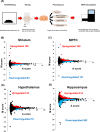Transcriptome analysis of sevoflurane exposure effects at the different brain regions
- PMID: 33320849
- PMCID: PMC7737892
- DOI: 10.1371/journal.pone.0236771
Transcriptome analysis of sevoflurane exposure effects at the different brain regions
Abstract
Backgrounds: Sevoflurane is a most frequently used volatile anesthetics, but its molecular mechanisms of action remain unclear. We hypothesized that specific genes play regulatory roles in brain exposed to sevoflurane. Thus, we aimed to evaluate the effects of sevoflurane inhalation and identify potential regulatory genes by RNA-seq analysis.
Methods: Eight-week old mice were exposed to sevoflurane. RNA from medial prefrontal cortex, striatum, hypothalamus, and hippocampus were analysed using RNA-seq. Differently expressed genes were extracted and their gene ontology terms were analysed using Metascape. These our anesthetized mouse data and the transcriptome array data of the cerebral cortex of sleeping mice were compared. Finally, the activities of transcription factors were evaluated using a weighted parametric gene set analysis (wPGSA). JASPAR was used to confirm the existence of binding motifs in the upstream sequences of the differently expressed genes.
Results: The gene ontology term enrichment analysis result suggests that sevoflurane inhalation upregulated angiogenesis and downregulated neural differentiation in each region of brain. The comparison with the brains of sleeping mice showed that the gene expression changes were specific to anesthetized mice. Focusing on individual genes, sevoflurane induced Klf4 upregulation in all sampled parts of brain. wPGSA supported the function of KLF4 as a transcription factor, and KLF4-binding motifs were present in many regulatory regions of the differentially expressed genes.
Conclusions: Klf4 was upregulated by sevoflurane inhalation in the mouse brain. The roles of KLF4 might be key to elucidating the mechanisms of sevoflurane induced functional modification in the brain.
Conflict of interest statement
The authors have declared that no competing interests exist.
Figures





Similar articles
-
Application of microRNA profiling to understand sevoflurane-induced adverse effects on developing monkey brain.Neurotoxicology. 2020 Dec;81:172-179. doi: 10.1016/j.neuro.2020.10.002. Epub 2020 Oct 9. Neurotoxicology. 2020. PMID: 33045284
-
Transcriptomic analysis reveals the molecular mechanism of Alzheimer-related neuropathology induced by sevoflurane in mice.J Cell Biochem. 2019 Oct;120(10):17555-17565. doi: 10.1002/jcb.29020. Epub 2019 May 27. J Cell Biochem. 2019. PMID: 31134678
-
The differential effects of isoflurane and sevoflurane on neonatal mice.Sci Rep. 2020 Nov 9;10(1):19345. doi: 10.1038/s41598-020-76147-6. Sci Rep. 2020. PMID: 33168900 Free PMC article.
-
MicroRNA-34c is regulated by p53 and is involved in sevoflurane-induced apoptosis in the developing rat brain potentially via the mitochondrial pathway.Mol Med Rep. 2017 Apr;15(4):2204-2212. doi: 10.3892/mmr.2017.6268. Epub 2017 Mar 1. Mol Med Rep. 2017. PMID: 28259954 Free PMC article.
-
Understanding Molecular Mechanisms of the Brain Through Transcriptomics.Front Physiol. 2019 Mar 15;10:214. doi: 10.3389/fphys.2019.00214. eCollection 2019. Front Physiol. 2019. PMID: 30930788 Free PMC article. Review.
Cited by
-
Whole-brain characterization of apoptosis after sevoflurane anesthesia reveals neuronal cell death patterns in the mouse neonatal neocortex.Sci Rep. 2023 Sep 7;13(1):14763. doi: 10.1038/s41598-023-41750-w. Sci Rep. 2023. PMID: 37679476 Free PMC article.
-
Sevoflurane Inhibits Traumatic Brain Injury-Induced Neuron Apoptosis via EZH2-Downregulated KLF4/p38 Axis.Front Cell Dev Biol. 2021 Aug 4;9:658720. doi: 10.3389/fcell.2021.658720. eCollection 2021. Front Cell Dev Biol. 2021. PMID: 34422795 Free PMC article.
-
General anesthetic action profile on the human prefrontal cortex cells through comprehensive single-cell RNA-seq analysis.iScience. 2023 Mar 31;26(4):106534. doi: 10.1016/j.isci.2023.106534. eCollection 2023 Apr 21. iScience. 2023. PMID: 37123239 Free PMC article.
-
Sevoflurane Exposure in Neonates Perturbs the Expression Patterns of Specific Genes That May Underly the Observed Learning and Memory Deficits.Int J Mol Sci. 2023 May 12;24(10):8696. doi: 10.3390/ijms24108696. Int J Mol Sci. 2023. PMID: 37240038 Free PMC article.
-
Identification of Prefrontal Cortex and Amygdala Expressed Genes Associated With Sevoflurane Anesthesia on Non-human Primate.Front Integr Neurosci. 2022 Jul 1;16:857349. doi: 10.3389/fnint.2022.857349. eCollection 2022. Front Integr Neurosci. 2022. PMID: 35845920 Free PMC article.
References
Publication types
MeSH terms
Substances
LinkOut - more resources
Full Text Sources

